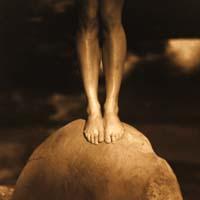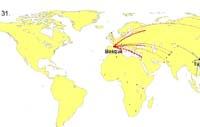From Africa to the world

Both approaches have been faced for many years. The bones and utensils found in the deposits, despite their valuable traces, have not been sufficient to reinforce or discard one of the two theories.
For this reason, genetics has acquired great importance in this field. Genetic studies have helped solve the doubt. In general, the more genetically they resemble at present two groups, the more possibilities they have of being the same ancestor. Therefore, the analysis of individual DNA, compared with that of the following, allows to draw conclusions about the past. Since genetics began working with this goal, numerous research has been carried out, most of which ratify the theory outside of Africa.
The latest research of this type has been carried out at the Cork University of Ireland and, in addition to confirming the theory of African origin, have analyzed how the expansion occurred. The results have been presented now and, in addition to the article, they have produced a video that represents migrations.
To carry out the research, 927 people from 53 different populations, including the Basque (Basque), have been analyzed. They have compared certain DNA fragments of these people, thus obtaining a lot of data. For their interpretation they have created a computer model that has allowed to know which of the possible migration models have more possibilities of being true.
In the video presented it can be observed that the species Homo sapiens colonized the world in nine phases. From Africa, the first migrations encompassed Europe and Asia, and the last ones to colonize were America and the Pacific islands. However, researchers have not dared to set dates for each migration and have recognized that each Europe and East Asia were colonized separately, but they do not know who happened before and after.
What they do have clear is that the oldest population is called San. Originating in southeastern Africa, they are hunter-gatherers. Until 3,000 years ago the bantos began to expand, it was they who dominated the territory, and have their genetic footprint the following four groups: the two and the Pygmy mbuti and the Bantos of South Africa and Kenya. Subsequently, the rest of the sub-Saharan populations are dominated by the footprint of the bantos.
In North Africa appear the Mozabs, where it seems that there was not as much confusion as in South Africa, since less populations appear in its DNA.
From Africa to other continents

From there the video jumps to the center of Eurasia. The researchers do not know how expansion occurred in this territory, but it seems that the populations of central Asia joined those of the Middle East. Anyway, in the DNA of its people appear remains of many populations, which meant a great confusion.
The next step appears in the centre of Europe. Beginning with the Adigei group, the first European populations settled and spread across France and Italy. In their groups are the remains of the Mozabs and the populations of the Middle East and Central Asia.
One more step and the east of Asia. The DNA of their groups makes it clear that the human beings who arrived there did not belong to the same migration that had gone to Europe, that is, those migrations occurred independently.
And in the next step appear the Basques, along with the Scottish sardines, Russians and orchids. As in the rest of Europe, remnants of central Asia and the Middle East appear in its DNA. Contrary to what some myths say, research speaks of the Basques being similar to Europeans.
A new leap to East Asia, where the team appears. This group has left a great mark on all the populations of the area.
And leaving Europe and Asia, researchers have explained how Homo sapiens spread to America. Apparently, the first Americans are Colombians and then the group of peppers appears in North America. The researchers have highlighted that the expansion in America occurred through two independent migrations. In the DNA of these two groups predominate the traces of the populations of East Asia, but in the following groups of America appear above all the traces of the first groups of America, except in the Maya group, with bantos remains, for example.
Finally, the Pacific islands appear. They have remains of eastern Asia, such as those of the Colombian group, but they also have remains of central Asia.
Many other details have been presented in the study. Therefore, the reading is slow. However, the video is easy to see and perhaps more than one seems strange or eye-catching the moment in which the Basque population appears.
Published in Gara
Buletina
Bidali zure helbide elektronikoa eta jaso asteroko buletina zure sarrera-ontzian











